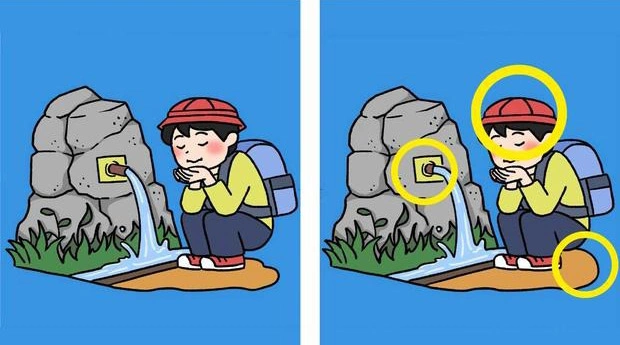Spot-the-difference puzzles aren’t just entertaining—they’re a fantastic brain booster! The challenge is easy to understand but can be surprisingly tricky: compare two nearly identical pictures and uncover the subtle changes. In this puzzle, you’ll see a boy kneeling beside a mountain spring, drinking fresh water with cupped hands from a stone fountain. Can you spot what’s different?

At first glance, both images look exactly alike — the boy’s posture, his backpack, the flowing water, and the serene mountain backdrop all seem identical. But hidden in plain sight are three subtle differences, and your challenge is to find them in under 15 seconds. Think it sounds easy? Think again. Spot-the-difference puzzles are addictive because they push your observation skills, memory, and attention to detail to the limit. What might jump out at one person can completely escape another — and that’s the thrill. Our brains are wired to notice big, sudden changes, not tiny tweaks, so these small alterations can be surprisingly tricky to catch unless you slow down and examine every detail carefully.
That’s exactly why these puzzles sharpen your mental focus—they force you to zero in on the little things. Before revealing the answers, it’s helpful to understand common pitfalls. One major mistake is rushing through the images. When nothing immediately stands out, your brain often assumes both pictures are identical — and those subtle changes slip past unnoticed. Another error is overlooking small details. Sometimes it’s a barely visible shape, a slight color shift, or a missing shadow that sets the two images apart. Without a systematic approach — scanning line by line or section by section — it’s easy to miss the key differences.
Now, let’s break down the solution step by step. Start by looking at the boy’s red hat. In the left image, two stitched lines run across the top, but in the right image, one of those lines is missing. It’s a tiny detail many overlook unless they focus on his head — that’s difference number one. Next, shift your gaze to the faucet protruding from the stone wall. In the left image, the tap is perfectly straight, while in the right, it’s bent slightly downward — a small but satisfying find. That’s difference number two. Finally, glance near the boy’s feet. In the left image, a small puddle of brown water pools beneath his shoes…
But in the right image, that puddle has completely vanished. If you happen to scan the lower part of the picture first, this might be the easiest difference to spot—but it’s surprisingly easy to overlook if your focus drifts elsewhere. And there you have it: the three hidden differences — the missing stitch on the hat, the bent faucet, and the absent puddle.
While it sounds simple once revealed, finding these subtle changes under time pressure is no easy feat. Spot-the-difference puzzles do more than entertain — they train your brain’s visual processing, memory, and concentration skills. Regular practice with these challenges can boost your cognitive flexibility and even help reduce stress, making them a fun and healthy workout for your mind.

Plus, spot-the-difference puzzles make a fantastic way to challenge friends and family in a fun, engaging way. If you want to sharpen your skills, try these strategies: mentally divide the image into a grid—whether four or nine squares—and scan each section carefully. Look out for repeated patterns, subtle color shifts, and slight changes in lines or shapes. Don’t overlook the edges and corners, either—those tricky spots often hide the sneakiest differences.
Once you’ve spotted all three, challenge others to beat your time! These puzzles are a perfect way to bond while giving your brain a boost. Drop your best time in the comments, tag a friend, and see who can spot the differences faster. Ready, set, go!